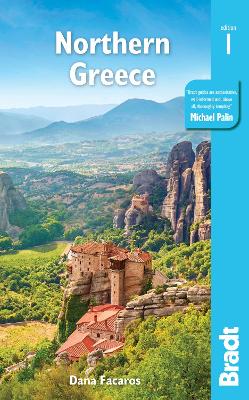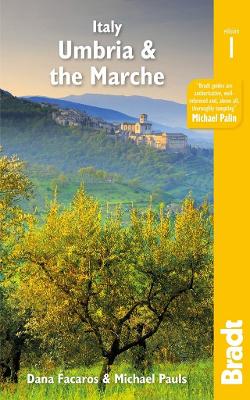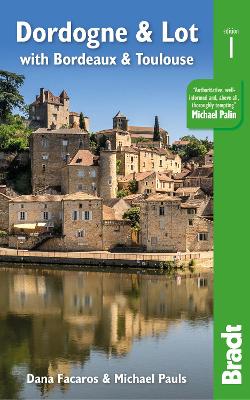Bradt Travel Guides
4 total works
This new title continues Bradt's coverage of lesser-known but increasingly popular Italian regions and is the only guide available to Friuli Venezia Giulia, a region that forms the major part of the hinterland of Venice (but does not - despite the name - include Venice itself), and which is a convenient and fascinating place to spend time on the beach, in the Alps or relaxing in the country. It is notable also for its wines and distinctive cuisine, which, with touches of neighbouring Austria and Slovenia stirred in, are starting to attract attention around the world.
Written by long-time travel authors and Italy specialists Dana Facaros and Michael Pauls, background and practical information are complemented by ten easy-to-follow chapters, covering Trieste, its coast and the Carso, the Friuli coast, Gorizia and the Collio, Udine, Pordenone and Western Friuli, and the mountains: the Friulian Dolomites, Carnia and the Julian Alps. Set in Italy's northeastern corner, Friuli Venezia Giulia is one of the most ethnically and culturally diverse parts of the country - and also one of the least known.
With Bradt's Friuli Venezia Giulia, explore this small but varied region in detail, from the Alps of the north to the coastal resorts, unspoiled wetlands and lagoons, and from medieval towns like Cividale del Friuli to the strange desert steppe called the Magredi and the lovely wine region of Il Collio. Discover the regional capital, caffeine-mad Trieste, where there are 67 different ways of ordering a cup of coffee, and Gorizia, one of the biggest battle fronts of World War I, which survives almost intact, with miles of trenches and fortifications open for exploration.
Bradt's Friuli Venezia Giulia offers everything you need for a successful trip.
Written by long-time travel authors and Italy specialists Dana Facaros and Michael Pauls, background and practical information are complemented by ten easy-to-follow chapters, covering Trieste, its coast and the Carso, the Friuli coast, Gorizia and the Collio, Udine, Pordenone and Western Friuli, and the mountains: the Friulian Dolomites, Carnia and the Julian Alps. Set in Italy's northeastern corner, Friuli Venezia Giulia is one of the most ethnically and culturally diverse parts of the country - and also one of the least known.
With Bradt's Friuli Venezia Giulia, explore this small but varied region in detail, from the Alps of the north to the coastal resorts, unspoiled wetlands and lagoons, and from medieval towns like Cividale del Friuli to the strange desert steppe called the Magredi and the lovely wine region of Il Collio. Discover the regional capital, caffeine-mad Trieste, where there are 67 different ways of ordering a cup of coffee, and Gorizia, one of the biggest battle fronts of World War I, which survives almost intact, with miles of trenches and fortifications open for exploration.
Bradt's Friuli Venezia Giulia offers everything you need for a successful trip.
This new guide to Northern Greece, written by Greece expert and long-time travel writer Dana Facaros, is the only guide available to the region and includes the areas of Epirus, Thessaly, Macedonia and Thrace, complete with their five dramatically beautiful national parks, the country's highest peaks and mountain lakes, rushing rivers and the world's deepest gorge, and (this is Greece, after all) long sandy beaches. Sections on background and practical information are followed by an easy-to-follow breakdown of the area offering detailed coverage in 12 chapters, from Greece's second city, Thessaloníki, to Chalkidikí, Central Macedonia, Eastern Macedonia, Thrace, Western Macedonia, Epirus (including Ioánnina), Thessaly and Magnesía, the Pelion Peninsula and the Islands, plus a short chapter on Athens, the gateway for many visitors to Greece.
Greece is becoming more popular by the year and this area in particular offers the more natural, authentic experience that many travellers seek. Bradt's Northern Greece focuses on just this relatively unknown but up-and-coming region and is an ideal companion for travellers of all ages, budgets and interests, from culture lovers to wildlife enthusiasts, history buffs to archaeologists, foodies to wine connoisseurs. Holidays in the great outdoors are covered, too, including mountain climbing, skiing, white water rafting, rock climbing, sailing, canyoning and sea kayaking, not to mention those who just want to sit on a sandy beach and dance the night away.
Greece is becoming more popular by the year and this area in particular offers the more natural, authentic experience that many travellers seek. Bradt's Northern Greece focuses on just this relatively unknown but up-and-coming region and is an ideal companion for travellers of all ages, budgets and interests, from culture lovers to wildlife enthusiasts, history buffs to archaeologists, foodies to wine connoisseurs. Holidays in the great outdoors are covered, too, including mountain climbing, skiing, white water rafting, rock climbing, sailing, canyoning and sea kayaking, not to mention those who just want to sit on a sandy beach and dance the night away.
Bradt's Umbria & the Marche is the most detailed guide to combine these two small central Italian regions, which offer all the beauty, history and culture of neighbouring Tuscany only without the crowds, the traffic or eye-popping prices. Dana Facaros and Michael Pauls (authors of the original Cadogan guide to the area) lived in Umbria in the 1980s and have been returning regularly and writing about it ever since. They are the perfect guides to the region's landscapes, hill towns, food and wine, and art and architecture.
The superb art cities of Umbria and the Marche steal the limelight - Perugia, Orvieto, Urbino, Assisi, Spoleto, Loreto, Todi, where art fills every church and palazzo. But never far from these centres wait unspoiled countryside of rolling olive groves, forests and meadows, long walks and towns and tiny villages, nearly all with a masterpiece or two to show off and a great little family-run restaurant. The Bradt guide covers them all, along with the republic of San Marino.
The Apennines rule here. The Marche's geography is dominated by a series of east-west river valleys - the Metauro, Esino, Tronto, etc - twisting down to the Adriatic and often ending in long sandy beaches, from the historic towns of Senigallia and Fano through Ancona's Cornero Riviera to the Riviera delle Palme at San Benedetto del Tronto. Landlocked Umbria, where rivers flow into the mighty Tiber, has exceptional water features as well: Italy's fourth largest lake, Trasimeno; the Tiber Valley; Clitunno springs (once sacred to the Romans); and Italy's most beautiful waterfall, the Cascata delle Marmore.
Featuring superb photography and expert recommendations to suit all budgets, Umbria & the Marche - the fifth in Bradt's increasingly highly regarded series of Italian regional titles - is a timely guide to a more authentic corner of Italy.
The superb art cities of Umbria and the Marche steal the limelight - Perugia, Orvieto, Urbino, Assisi, Spoleto, Loreto, Todi, where art fills every church and palazzo. But never far from these centres wait unspoiled countryside of rolling olive groves, forests and meadows, long walks and towns and tiny villages, nearly all with a masterpiece or two to show off and a great little family-run restaurant. The Bradt guide covers them all, along with the republic of San Marino.
The Apennines rule here. The Marche's geography is dominated by a series of east-west river valleys - the Metauro, Esino, Tronto, etc - twisting down to the Adriatic and often ending in long sandy beaches, from the historic towns of Senigallia and Fano through Ancona's Cornero Riviera to the Riviera delle Palme at San Benedetto del Tronto. Landlocked Umbria, where rivers flow into the mighty Tiber, has exceptional water features as well: Italy's fourth largest lake, Trasimeno; the Tiber Valley; Clitunno springs (once sacred to the Romans); and Italy's most beautiful waterfall, the Cascata delle Marmore.
Featuring superb photography and expert recommendations to suit all budgets, Umbria & the Marche - the fifth in Bradt's increasingly highly regarded series of Italian regional titles - is a timely guide to a more authentic corner of Italy.
Bradt's Dordogne & Lot, with Bordeaux & Toulouse is the most detailed guide to the entire region, with coverage that includes the Lot-et-Garonne and Tarn-et-Garonne in addition to Dordogne, Lot and Bordeaux. Dana Facaros and Michael Pauls (authors of the original Cadogan guide to the area) have lived in the Lot valley for over thirty years and are the perfect guides to the region's landscapes, towns, food, art, architecture and, of course, wine: Bordeaux's 8,800 wine châteaux produce on average 650 million bottles a year!
Their guide starts with Bordeaux, the capital of the Nouvelle-Aquitaine region as well as the world capital of wine, along with the départements of the Gironde, Dordogne, Lot, Lot-et-Garonne, and Tarn-et-Garonne in between. This is a land of great wines and stunning rivers, encompassing long sandy beaches along the Côte d'Argent (with Europe's biggest sand dune on the south end), forests and rolling hills. Here, too, are the UNESCO-listed Prehistoric Sites and Decorated Caves of the Vézère Valley, and extraordinary Palaeolithic masterpieces (Lascaux, Font de Gaume and Pech Merle). History has been made here, evidenced in medieval castles and bastides, and beautiful old cities such as Sarlat, Périgueux, St-Émilion, Cahors and Figeac. Hundreds of unspoiled villages dot landscapes that are among the most idyllic in France, while Romanesque churches, including the great abbey at Moissac, are a feast for art lovers.
Outdoor activities are well covered, too, including cycling, sailing, surfing, canoeing, kayaking and walking the numerous Grand Randonnées (including three main routes of the Camino de Santiago) that pass through here, along with scores of other paths. And last but not least, the food is good: think truffles, oysters, duck, saffron, strawberries and melons, walnut groves and orchards. The weekly markets are gorgeous, and the summers are filled with wine, music and theatre festivals.
All of this and more is covered by expert authors Dana Facaros and Michael Pauls in this new title from Bradt, offering all the information you need both prior to departure and while on the road.
Their guide starts with Bordeaux, the capital of the Nouvelle-Aquitaine region as well as the world capital of wine, along with the départements of the Gironde, Dordogne, Lot, Lot-et-Garonne, and Tarn-et-Garonne in between. This is a land of great wines and stunning rivers, encompassing long sandy beaches along the Côte d'Argent (with Europe's biggest sand dune on the south end), forests and rolling hills. Here, too, are the UNESCO-listed Prehistoric Sites and Decorated Caves of the Vézère Valley, and extraordinary Palaeolithic masterpieces (Lascaux, Font de Gaume and Pech Merle). History has been made here, evidenced in medieval castles and bastides, and beautiful old cities such as Sarlat, Périgueux, St-Émilion, Cahors and Figeac. Hundreds of unspoiled villages dot landscapes that are among the most idyllic in France, while Romanesque churches, including the great abbey at Moissac, are a feast for art lovers.
Outdoor activities are well covered, too, including cycling, sailing, surfing, canoeing, kayaking and walking the numerous Grand Randonnées (including three main routes of the Camino de Santiago) that pass through here, along with scores of other paths. And last but not least, the food is good: think truffles, oysters, duck, saffron, strawberries and melons, walnut groves and orchards. The weekly markets are gorgeous, and the summers are filled with wine, music and theatre festivals.
All of this and more is covered by expert authors Dana Facaros and Michael Pauls in this new title from Bradt, offering all the information you need both prior to departure and while on the road.



